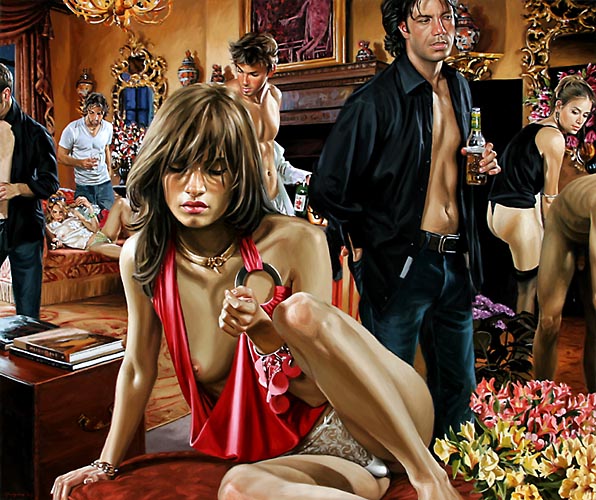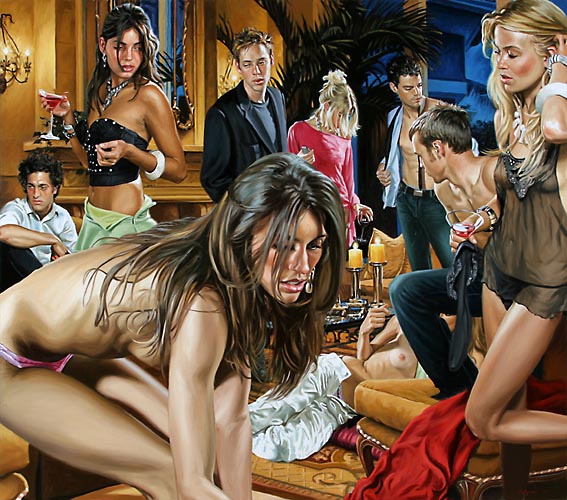Terry Rodgers
By Cathy Byrd for Art in America, February 2006, No.2

Terry Rodgers is a realist known for his contemporary character studies. While his earlierpaintings often contemplated personal and family relationships in brightly lit outdoor settings wrought with pale, intense, high-keyed colors, his recent paintings conjure up avision of the private nightlife of America’s privileged youth. Widely exhibited in the U.S.and Europe and noted for their subtle social commentary, Rodgers’s large-scale oil paintings (as much as 5 feet high and 6 feet wide) are often based on photographs and are meticulously laid out with computers.
The works recently on view at Fay Gold in “American Rhapsody” depict beautiful and richyoung partygoers posing in a series of finely appointed settings. Paintings by Julian Schnabel, Francis Bacon and other darkly stylish artists haunt the walls of each opulent salon where revelers absently commune with each other over champagne and white wine, boutique beer and ruby-colored cocktails. The women are nonchalant about their silky hair, often-exposed breasts and lustrous skin, the hunky men seemingly unaware of both the women and their own perfection. Beneath the cool chic, a narcotic aura emanates from the six tableaux.

In shades of crimson, bluish gray and black, embellished with gold, bronze, silver and pearl pigments, Rodgers’s complex compositions emphasize the detachment of hischaracters: the eye can trace the angles and curves of their intersecting bodies on the painting’s surface, but their gazes almost all diverge from each other. They seem to share the disappointment of F. Scott Fitzgeralds’s hollow glamour seekers and the bourgeois ennui mined by Eric Fischl and David Salle.
The artist positions the viewer as voyeur. Imaging Life (2005) takes place in a room swathed in red velvet and burnished with golden light. Three full-lipped blondes, scantilyclad and with breasts exposed, disregard a set of equally apathetic male companions, in evening wear or various states of undress. The pouting, heavy-lidded young woman in the foreground of Vague Inferences (2005) supports herself uncertainly on one slender arm. Draped in ared halter and wearing a lacy thong, she exposes abreast and flawless legs. Yet she seems invisible t the sun-kissed men in her orbit, and though they are naked, half-dressed or disrobing, she ignores them. Each figure seems lost in a private reverie. Rodgers’s characters seem primed for an orgy, if they could only notice one another.
The paintings’ sarcastic titles point to the artist’s certainty that real life is elsewhere. Alternative Fictions (2005), depicting another endless party populated by undressing men and statuesque women in negligees, continues the theme of disconnectedness: all are present, yet absent, proving the show to be an elegy to emptiness.
2006